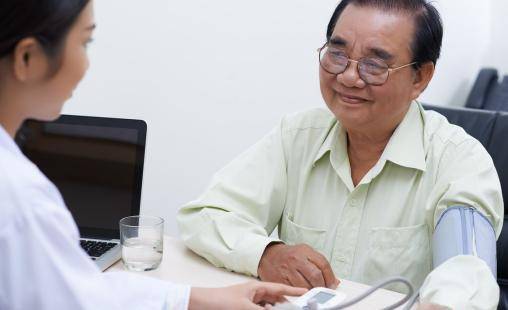People often talk about high blood pressure, but do you know what blood pressure is?
Blood pressure is the pressure that blood exerts on the walls of blood vessels when flowing inside them; if the blood pressure values measured nearly three times reach or exceed 140 millimeters of mercury for systolic pressure or 90 millimeters of mercury for diastolic pressure without taking medication, it can be called high blood pressure.
If the blood pressure is too high, the pressure on the blood vessels will increase, and over time, various pathologies may appear.
If the body shows the following 4 signs, be vigilant:
1. Dizziness, headaches, palpitations, etc., mostly occur when excessively fatigued or under severe stress.
2. In severe cases of high blood pressure, there may be symptoms such as blurred vision and nosebleeds.
3. When a person with high blood pressure experiences transient cerebral ischemia, there may be severe dizziness or vertigo.
4. When complications occur, symptoms such as chest tightness, chest pain, and shortness of breath may appear.
To prevent blood pressure from exceeding the standard level, remember the “3 Nos”:
1. No Smoking
Regular smoking can stimulate the adrenal glands due to nicotine entering the body, causing the release of a large amount of catecholamines, accelerating heart rate, constricting blood vessels, and thus raising blood pressure. Frequent smoking may cause vasospasm, smooth muscle degeneration, thickening of blood vessel walls, accelerated arteriosclerosis, thereby affecting blood pressure stability.
Additionally, regular smokers may have difficulty maintaining stable blood lipid levels, excessive lipid accumulation can accelerate arteriosclerosis development, affecting blood pressure stability with significant fluctuations.
2. Avoid Excessive Stress
When people are in a state of anxiety, tension, or high stress, the body’s sympathetic nervous system is overly excited, leading to increased secretion of catecholamines, accelerated heart rate, blood flow, and increased peripheral vascular resistance, ultimately causing a rise in blood pressure. It’s best to keep oneself in a joyful and emotionally stable state.
3. Avoid Staying up Late
Frequent late-night hours will increase the secretion of stress hormones in the body, such as adrenaline and noradrenaline, causing blood vessel spasm, making blood pressure difficult to stabilize. It is best to go to bed before 11 p.m. regularly to ensure 7-8 hours of adequate sleep.
For individuals with high blood pressure, consume less of the “2 Yellow, 2 White” foods to help stabilize blood pressure:
“Less Yellow”:
1. Baked Foods
Commonly consumed foods like biscuits, cakes, etc., contain high sugar content, easily leading to obesity, high blood sugar, damaging blood vessel health, accelerating atherosclerosis development, which affects blood pressure stability. Additionally, frequent consumption of these foods may increase blood viscosity, raise the likelihood of blood clot formation, and increase the occurrence of vascular diseases.
2. Fried Foods
After foods are fried, they not only lose nutrients but also produce a large amount of trans-fatty acids and saturated fatty acids, which accumulate in the bloodstream, raising levels such as triglycerides, unfavorable for stable blood lipid levels. Over time, blood vessels harden, making it challenging to maintain stable blood pressure.
“Less White”:
1. Salt
It is well-known that excessive salt consumption raises blood pressure levels. Research results show that the average daily salt intake per person in China is 7-20g, while the World Health Organization recommends a daily salt intake of no more than 6g. Eating too much salt can cause sodium accumulation in the body, leading to sodium and water retention, cellular swelling, narrowing of blood vessel lumens, and increased blood vessel pressure.
2. Alcohol
Alcohol also plays a “significant role” in raising blood pressure. Alcohol causes blood vessel dilation, but after about half an hour, the alcohol concentration in the body peaks. At this point, the sympathetic nervous system is highly excited, causing blood vessel recontraction and easily elevating blood pressure. Alcohol consumption also increases the levels of cortisol, catecholamines, and external vascular resistance, leading to blood vessel spasms and elevated blood pressure levels.
By regularly adhering to three activities, blood pressure can be more stable, and dizziness can be reduced:
The First: Drink More Water
Drinking water has a positive effect on blood vessel health. Immersing small plants beneficial for clearing blood vessels like chrysanthemum can bring better results. Chrysanthemum contains elements beneficial to blood vessels, such as selenium, flavonoids, and choline, which can help improve blood viscosity, prevent clot formation, reduce vessel damage caused by free radicals, and promote vascular repair.
The Second: Stay Active
Being physically active can accelerate metabolism, reduce obesity, lower lipid deposition in the blood, enhance fibrinolytic enzyme activity, and help stabilize blood pressure levels. Engaging in aerobic exercises like jogging, walking, Tai Chi, brisk walking, at least four times a week, is ideal, ensuring the body gently perspires in each session.
The Third: Monitor Blood Pressure
For non-hypertensive individuals without risk factors, measuring blood pressure every six months is sufficient; for those with genetic or risk factors but are not hypertensive patients, monthly measurements are recommended. Newly diagnosed hypertensive patients should measure 2-3 times daily. Long-term hypertensive patients with stable blood pressure control should measure 1-2 times a week; if blood pressure control is unstable, daily measurements of 1-3 times are necessary.


